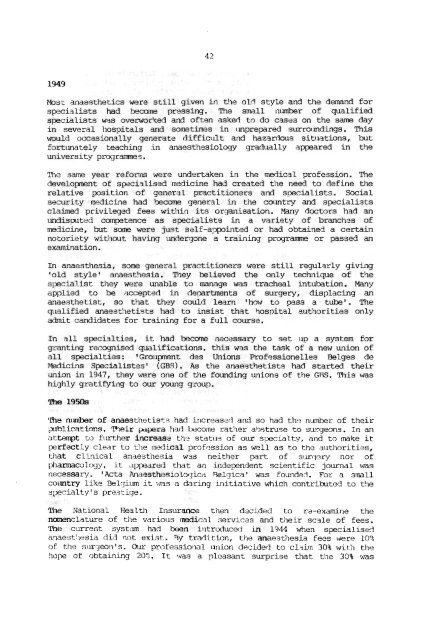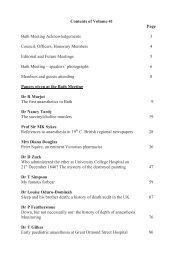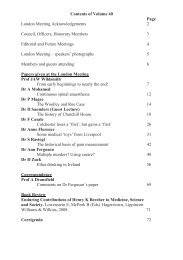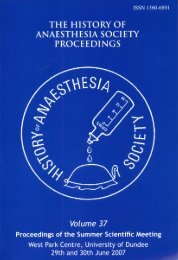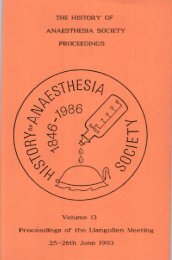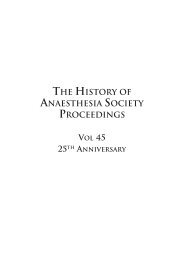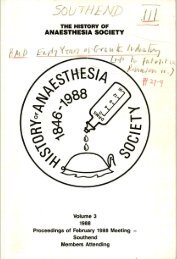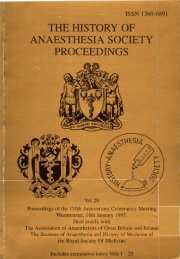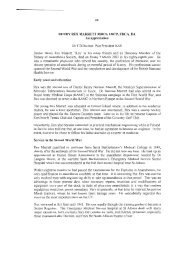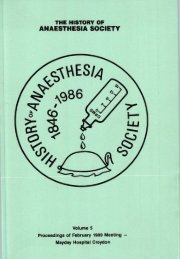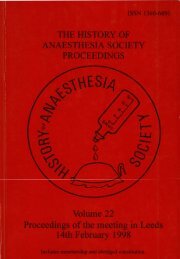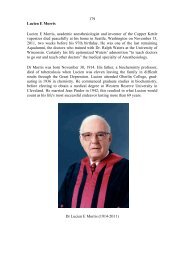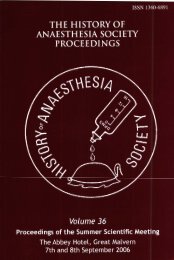3 - History of Anaesthesia Society
3 - History of Anaesthesia Society
3 - History of Anaesthesia Society
Create successful ePaper yourself
Turn your PDF publications into a flip-book with our unique Google optimized e-Paper software.
Most anaesthetics were still given in the old style and the demand for<br />
specialists had km pressing. The mall 11umber <strong>of</strong> qualified<br />
specialists was ovemr'ced and <strong>of</strong>ten asked to do cssea on the same day<br />
in several llospitals and sometires in ~rnprepred surro~mdings. This<br />
would occasionally generate Aiffic~iLt and hazardous situations, but<br />
fortunately teaching in anaesthesiology gradually appeared in the<br />
university prqranmes.<br />
llle same year reform were undertaken in the mediml pr<strong>of</strong>ession. The<br />
developnent <strong>of</strong> spcislised medicine had created the need to define the<br />
relative position <strong>of</strong> general practitioners and soecialists. Social<br />
security mdicine had bcme general in the country and specialists<br />
claimed priviLeged fees within its orpisation. .%ny doctors h3d an<br />
undiscuted canpetence as specialists in a variety <strong>of</strong> branchzs <strong>of</strong><br />
medicine, but some were ju~t sslf-awinted or had obtained a certain<br />
notoriety without havinq undergone a training progrannne or passed an<br />
examination.<br />
In anaesthesia, some general practitioners were still regularly giving<br />
'old style' anaesthesia. They believed the only technique <strong>of</strong> the<br />
spcial-ist they were unable to manage was tracheal intubation. Many<br />
applied to be dccepted in demrtments <strong>of</strong> surgery, displacing an<br />
anaesthetist, so that they could learn 'how to pass a tube1. The<br />
qislified anaest:~etists had to insist that hospital authorities only<br />
admit candidates for training for a €1111 course.<br />
In 311 specislties, it had hem necessary to set rip a system for<br />
granting recognised qualifications. this ms the task <strong>of</strong> a new union <strong>of</strong><br />
all spxialties: 'Groupnent des Unions bfsssionelles Belges de<br />
Medicins Specialistes' (GBS). As the anaesthetists had started their<br />
union in 1947, they were one <strong>of</strong> the founding unions <strong>of</strong> the GHS. This was<br />
highly gratifying to our young qroup.<br />
'[he nlnnber <strong>of</strong> anaesthetists had increased and so had the nmhr <strong>of</strong> their<br />
whlicatims. Their ppers had t~come rather abqtruse to surgeons. In an<br />
attempt to further incrsasz ti?~ status <strong>of</strong> our spcialty, and to make it<br />
prfectly clear to the m~dical pr<strong>of</strong>ession as well as to the authorities,<br />
that clinical anaesthesia wss neither part <strong>of</strong> surqery nor <strong>of</strong><br />
pharnucolay, it appeared that an independent scientific journal was<br />
necessary. 'Acta Anaesthesiologica Wlgica' was foundeft. For a small<br />
colrntry like Bel9ium it was a daring initiative which contriktcd to the<br />
slxzialtyf s pre.3tiye.<br />
Pie National Health Insurance then dacided to re-examine the<br />
nomenclature <strong>of</strong> the various medical services and their sc4e <strong>of</strong> fees.<br />
The clment system had heen introduced in 1344 when specialised<br />
iinaest!~esia did not exist. Py tradition, the anaesthesia fees were 10%<br />
<strong>of</strong> the surgeon's. Cur proEessiona1 union decided to clsim 30% with the<br />
hope <strong>of</strong> obtaining 20%. It !ms a plcasant surprise that the 30% was


